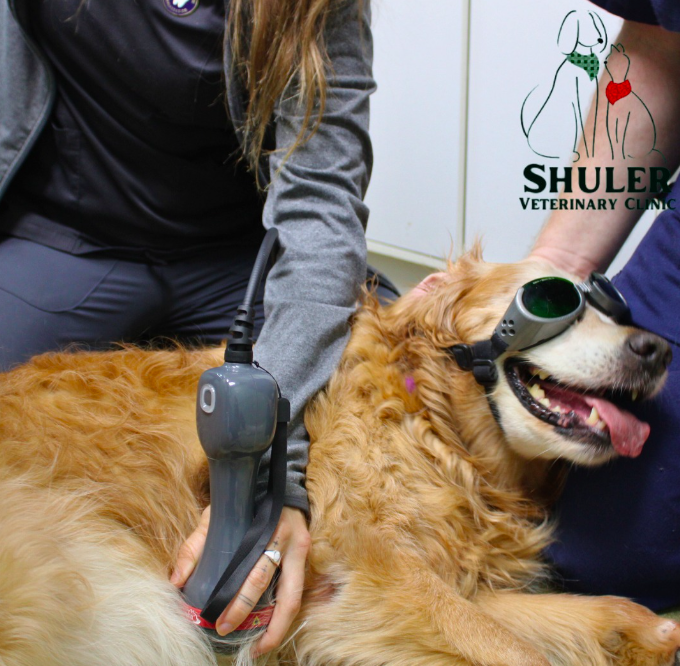Many people associate laser beams with laser pointers or barcode scanners rather than with pain management and healing. However, laser therapy is an exceptionally beneficial treatment modality for pets and can improve a great many conditions. To determine whether laser therapy may be helpful in resolving your pet’s health issues, read our Shuler Veterinary Clinic team’s guide to this alternative treatment modality.
What is veterinary laser therapy?
Laser therapy is a form of veterinary rehabilitation. To achieve maximum results when managing pets’ pain and boosting their healing, veterinarians often used this alternative treatment modality in conjunction with other therapies.
How does laser therapy work in pets?
Using specific wavelengths, a veterinary professional directs laser light toward your pet’s injured tissue, whether your four-legged friend has a superficial ear infection or deep bone fracture. During the treatment process, a veterinary professional uses the frequencies of laser light (i.e., photobiomodulation) to trigger the cells to reproduce, grow, and heal, essentially accelerating their natural processes. When cellular processes are stimulated, your pet will experience:
- Muscle relaxation
- Endorphin release
- Circulation improvement
- Decreased inflammation and pain
- Quicker wound healing and repair
Why is laser therapy so beneficial for pets?
With many therapies, particularly pharmaceutical and surgical options, their side effects range in severity. While side effects can be mild, some are so serious that you and our Shuler Veterinary Clinic team may have to decide whether continuing a specific therapy is worth impairing your pet’s quality of life. Laser therapy eliminates these concerns, as it is one of the few modalities that is drug-free, pain-free, surgery-free, and noninvasive. This treatment modality is particularly beneficial for cats, senior pets, and anxious pets, as they may be ineligible for other therapies. In addition, laser therapy can be especially beneficial for pets who:
- Cannot safely take medication because of organ dysfunction or concurrent illness
- Are not good anesthesia or surgical candidates
- Are unable to be medicated at home safely and effectively
- Have few other therapeutic options for their condition
- Will not tolerate other therapies such as acupuncture or chiropractic care.
How does laser therapy help pets?
All types of conditions can benefit from laser therapy. This treatment modality can help reduce a pet’s pain and inflammation, and promote healing in a wide range of conditions. Superficial or acute conditions that can benefit from laser therapy include:
- Surgical incisions
- Traumatic injuries
- Wounds
- Anal gland inflammation and infection
- Gingivitis and stomatitis
- Ear hematoma or infection
In addition to helping resolve relatively mild issues, this treatment modality can help heal more severe conditions and injuries. Chronic or deep-tissue conditions that can benefit from laser therapy include:
- Osteoarthritis
- Bone fractures
- Cranial cruciate ligament (CCL) tears
- Skin allergies
- Acral lick granulomas
- Hip dysplasia
- Intervertebral disc disease (IVDD)
How can I determine whether laser therapy is right for my pet?
While laser therapy can improve virtually any inflammatory condition, not all pets with pain and inflammation are ideal candidates for this treatment modality. To be able to tolerate laser therapy, your pet must be able to remain still for an extended period while veterinary professionals administer the treatment. If your pet is too excitable to hold still or too nervous to be restrained, they are likely not a good candidate for this treatment modality. In addition, your pet may not have a condition that responds well to laser therapy, or other therapies may be more effective. To determine whether laser therapy is a good option for your pet’s condition, give our Shuler Veterinary Clinic team a call.
What can I expect during my pet’s laser therapy appointment?
During a laser therapy session, everyone in the room, including your pet, must wear goggles to protect their retinas. The veterinary professional will hold the laser handpiece in contact with your pet’s skin, or just above for treatment of an open wound.
Depending on your pet’s condition, their laser therapy sessions can last anywhere from a few minutes to half an hour. Acute, superficial issues need less time; whereas deep, chronic conditions can require a minute or more per treatment area. If your pet has arthritis in their hips, elbows, and knees, their treatments may take half an hour, while boosting an infected anal gland’s healing ability may take less than a minute.
The number of sessions your pet will require also depends on their condition. A chronic condition may need weekly sessions until enough improvement occurs to begin lengthening the time between treatments, while acute issues may need treatment every other day until healed.
What are veterinary laser therapy’s side effects?
Veterinary laser therapy creates few, if any, adverse side effects. During the session, your pet may feel some heat from the handpiece, but this warmth is typically soothing rather than uncomfortably hot.
A therapeutic laser should not be used over reproductive organs, the thyroid gland, or bone growth plates. However, in almost every other instance, this treatment modality can provide some healing effect. Laser therapy contraindications include:
- Pregnancy
- Cancerous masses
- Ocular conditions
- Active bleeding
- Immunocompromising illness
- Systemic infection
- Fungal infections
If you are interested in trying laser therapy for your pet’s condition, schedule a consultation and initial session with our Shuler Veterinary Clinic team.









Leave A Comment